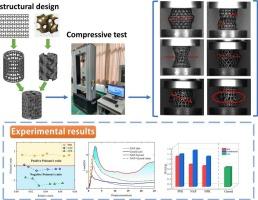Compressive response of concave negative Poisson’s ratio cylindrical shell/TPMS core composite structures
IF 7.9
2区 材料科学
Q1 MATERIALS SCIENCE, MULTIDISCIPLINARY
引用次数: 0
Abstract
Conventional concave cylindrical shells, though lightweight, are prone to early failure under compression due to instability, limiting their energy absorption potential. This study introduces a hybrid shell–core design by integrating three types of concave shells with a Gyroid-based triply periodic minimal surfaces (TPMS) core to form a hierarchical structure that enhances both compressive stability and energy dissipation. Compression tests were conducted to examine mechanical performance and deformation behavior. Results show that alternating positive–negative units (NAP) consist of alternating positive and negative Poisson’s ratio units. Their peak load is ∼ 16 % higher than negative Poisson’s ratio units (NPR) and ∼ 60 % higher than positive ones (PPR), though specific energy absorption (SEA) is reduced.With TPMS integration, the NPR-based composite achieves 47 % improvement in both peak load and SEA, while the NAP composite attains a 63 % SEA increase. The failure modes of the three types of composite structures were different, with the PPR structure producing a peeling of the inner core and outer shell during failure, the NPR structure fracturing due to the extrusion of the inner and outer structures, and the NAP structure maintaining high loads due to the coupling of the first two deformations. This work demonstrates the effectiveness of shell-core synergistic mechanisms in optimizing structural properties and opens new avenues for designing lightweight, impact-resistant protective metamaterials in fields such as aerospace and automotive engineering.

凹负泊松比圆柱壳/TPMS核心复合结构的压缩响应
传统的凹圆柱壳虽然重量轻,但由于不稳定,在压缩下容易早期失效,限制了它们的能量吸收潜力。本文介绍了一种混合壳核设计,将三种凹壳与基于陀螺的三周期最小表面(TPMS)核相结合,形成层次化结构,增强了压缩稳定性和能量耗散。进行了压缩试验,以检查力学性能和变形行为。结果表明,交替正负泊松比单元由交替正负泊松比单元组成。它们的峰值负荷比负泊松比单元(NPR)高~ 16%,比正泊松比单元(PPR)高~ 60%,尽管比能量吸收(SEA)降低了。与TPMS集成后,基于npr的复合材料的峰值负载和SEA都提高了47%,而NAP复合材料的SEA提高了63%。三种复合材料结构的破坏模式不同,PPR结构在破坏过程中产生内核和外壳的剥落,NPR结构由于内外结构的挤压而破裂,NAP结构由于前两种变形的耦合而保持高载荷。这项工作证明了壳核协同机制在优化结构性能方面的有效性,并为在航空航天和汽车工程等领域设计轻质、抗冲击保护超材料开辟了新的途径。
本文章由计算机程序翻译,如有差异,请以英文原文为准。
求助全文
约1分钟内获得全文
求助全文
来源期刊

Materials & Design
Engineering-Mechanical Engineering
CiteScore
14.30
自引率
7.10%
发文量
1028
审稿时长
85 days
期刊介绍:
Materials and Design is a multi-disciplinary journal that publishes original research reports, review articles, and express communications. The journal focuses on studying the structure and properties of inorganic and organic materials, advancements in synthesis, processing, characterization, and testing, the design of materials and engineering systems, and their applications in technology. It aims to bring together various aspects of materials science, engineering, physics, and chemistry.
The journal explores themes ranging from materials to design and aims to reveal the connections between natural and artificial materials, as well as experiment and modeling. Manuscripts submitted to Materials and Design should contain elements of discovery and surprise, as they often contribute new insights into the architecture and function of matter.
 求助内容:
求助内容: 应助结果提醒方式:
应助结果提醒方式:


